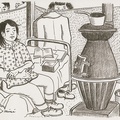Part 4 >>
Henry (Hank) Nobuo Hirabayashi
Hank Nobuo Hirabayashi was born in Seattle on April 29, 1923. His father, Hamao, appears in many early photographs taken during the first decade of the 1900s with his bachelor cousins and friends. He was one of the earliest to emigrate and urged his cousins to join him. The families were to maintain close relationships throughout the pre-war years. Beginning in a day job in a hotel in Tacoma, Hamao saved his money and eventually opened the Belltown Grocery in Seattle:
We were about a half-mile directly north of the Pike Place Market on First Avenue. We lived in the back of the store and had a nice view of Elliott Bay and West Seattle. At that time, Belltown was known as part of Skid Row, so it was not the best place to grow up. In our block alone there were three taverns and three houses of ill repute and on weekends there were many fistfights in the street.
Hank’s mother, Sanae, arrived to America from Okayama prefecture with her parents when she was fourteen. In Seattle she attended a local grade school: “She spoke English fairly well for an Issei.” Her parents, the Numotos, also ran a grocery store nearby. “I had grandparents, one of the few Nisei to have grandparents in this country.”
Contact with his cousins in Thomas came through informal family gatherings, particularly on holidays. His mother had converted to Christianity and encouraged Hank to go to church. He was therefore raised as a Christian. Before attending elementary school he was sent by bus to the Japanese Baptist Church preschool. During his high school days, he went to Blaine Methodist Church in Seattle, a Japanese American congregation known today as Blaine Memorial United Methodist church.
Few Japanese families resided in Hank’s neighborhood, and only three or four Nisei attended his grade school. At Queen Anne High School, most of his schoolmates were white. Aside from attending regular classes, his extracurricular activities were concentrated in sports. Prior to the war, an important activity among his classmates involved participating in the National Guard. Twice a week they went to train at the armory, located not far from his family’s grocery store: “I tried to get in, and they rejected me because I’m Japanese. That left quite an impression on me.”
Hank graduated from Queen Anne High School in 1941. That summer, he visited a friend on the Olympic Peninsula: “It was an isolated place where you could fish and hunt, and I wanted to buy some land and settle out there. There was logging, fishing, oysters, a lot of things to do to get by on.” But he returned to Seattle, and just before December 7, he was hired on at a fish processing plant on the waterfront through an Issei contact in the neighborhood. The next day, Hank’s father, president of the Seattle Japanese Grocer’s Association and a prominent member of the community, was arrested by the FBI and detained at the federal immigration station on Airport Way. Hank tried to visit him:
There was somebody waving through the bars, so I was waving, and right away the guards came, took me into the building and threatened to put me behind bars. Finally they let me go, but they wouldn’t let me see him. It was a traumatic experience.
Being the eldest son, Hank had to shoulder all of the family responsibilities: closing the store, selling the inventory and equipment, arranging for the family possessions, and preparing for their impending incarceration. In May 1942 they boarded a bus that took them to the temporary detention center in Puyallup. Later that summer they were sent by train to the Minidoka camp in Idaho.
Initially, Hank worked at the camp canteen. During the fall of 1942 he left on a temporary work furlough to harvest sugar beets and potatoes. When harvest ended he returned to camp. Soon the Army came to camp looking for volunteers for the 442nd RCT: “Mike Masaoka came to recruit, and for some reason I missed him. But I heard that a lot of people were impressed with his presentation because he was a dynamic speaker.” Referring to the loyalty questionnaire, Hank said: “I was willing to serve, so I signed ‘yes, yes.’”
During the fall of 1943, Hank signed on with the National Youth Administration (NYA) to attend a vocational school program in Weiser, Idaho. He acquired skills in auto mechanics. He then moved to Salt Lake City, where he served tables at a University of Utah sorority house. He then tried to enlist in the Army Air Force, but was rejected: “I had an enemy alien status.” He wanted to become a mechanic and subsequently attempted to enter the aeronautical mechanics program at Weber State College: “I couldn’t get into that either.” He returned to camp.
On February 6, 1944, the army scheduled visits to the ten camps administered by the War Relocation authority to register all male Nisei of draft age. Recalling events surrounding his refusal to comply with the draft, Hank said: “I guess it was when the draft actually came. Up until then, I guess it was a slow process of starting to think about what was happening.” He thought about his rejection by the National Guard, his father’s sudden disappearance and detention, the Army Air Force rejection, and his inability to enter the aeronautical mechanics program at Weber State College.
I was always told by my parents that if anything ever happened between Japan and the United States, it was my duty to go to the army. As a citizen that’s my obligation. I started to reflect on it; it just didn’t make sense to me – to be in camp and have to be drafted without having a choice. It just wasn’t right.
Hank decided to refuse induction. He learned there were other dissidents in camp who decided to resist the draft because of the loss of civil rights. 32 The day they were to be inducted, U.S. marshals arrested several of them, including Hank, and they spent the first night in the Twin Falls jail. They were then taken to the Emmet County jail where they sat for two months. Hank’s trial was subsequently held in Boise, Idaho.
When my draft call came, I sent an appeal by a registered letter. The plea was not guilty on the basis that my citizenship rights were denied. My court appointed lawyer told me there is no way out of this, you violated the draft order. Your only out is the registered letter. I had the receipt but the head of the selective service from Seattle swore he never got it.
Some of the dissidents changed their plea to guilty, and the judge gave them lighter sentences of two years. Hank did not change his stand: “I remained with the non-guilty plea and got three years and three months.”
Hank was sent directly to McNeil Island Federal Penitentiary. Initially, he and the other Minidoka resisters were confined in the main prison. Later they were transferred to the penitentiary farm. They were assigned various jobs: “I happened to work on the newspaper.” There were classes: “I caught up on my education with math, calculus, and vocational training.” With time off for good behavior, Hank was incarcerated for less than three years.
On Christmas Eve, 1947, Hank and the other convicted draft resisters received a pardon from President Harry Truman. 33
After his release from prison Hank returned to Seattle and stayed with his parents. For a year he worked as a gardener. But then he decided to tour the country. “Went by bus, no idea where to go.” He performed odd jobs along the way and got married in Los Angeles. After a brief venture in the Los Angeles grocery business, he returned to Seattle and established himself as a successful grocer in the University District. A health problem ultimately forced him into retirement. As of 2002 he lives with his wife across Lake Washington in a community east of Seattle.
A Question of Identity
As the four Nisei cousins negotiated issues of race, identity, and nationality in the context of life in the Pacific Northwest, their life histories represent individual trajectories. They should not be viewed as mere casualties of the times, but as proactive participants in decision-making concerning their lives during a critical period. They were socialized in a nurturing Issei community as they and their Nisei cohorts created their own communities. The Nikkei community evolved within the context of American society, harmonized with the fundamental precepts of American life, the basic tenets being embedded in the Constitution.
Religious training played a significant role in the socialization of the Nisei cousins. On Sunday mornings the cousins and their siblings would jump onto the back of a flatbed truck for a three-mile drive to the Union Sunday School. They looked forward to Sunday evenings when the Mukyokai fellowship met in each other’s homes, where potluck dinners meant there would be lots of “goodies” to eat, important particularly during the Depression years. Learning proper behavior was a daily affair and, as Gordon said, it came mainly through examples:
What’s good, truth – it’s not unique to Japanese or English teaching. A good portion of the influence of the parents didn’t come from their lecturing to me and disciplining me; their teaching came by their doing it. The one basic principle of truth – if it’s valid on Sunday it’s valid on Monday too; one principle for all people.
Grant was exposed to alternative religious thought during his school years in Japan. He observed the religious philosophies of Buddhism, Shintoism, and Confucianism and saw them as congruent with his Christian beliefs. Christianity was linked to his identity as an American, albeit in a Japanese environment: “I think I kept it separate as long as it didn’t invade my privacy, because there was no one telling me that I can’t believe in Christianity.”
Henry’s relationship to Mukyokai influences was the most peripheral of the experiences of the four Nisei cousins. He lived in Seattle some twenty-five miles from his Nisei cousins and saw them only on special occasions. At home, religious influences came from his mother, his Baptist preschool, and the Blaine Methodist Church with its Japanese American congregation.
The cousins were socially entrenched in the local Nikkei communities. Their families belonged to various Issei regional associations as well as to the local Japanese Association. Henry’s father, additionally, was the president of the Seattle Japanese Grocer’s Association. The cousins’ exposure to mainstream American life was largely through the educational system. They were not taught by the Issei to become nationals of Japan. They grew up within the Japanese American and American communities and never questioned their identities as Japanese Americans and Americans.
Henry’s exposure to mainstream society was the strongest among the cousins. Most of his high school friends were Caucasians. Grant was extensively exposed to Japanese life with his eight years of education in Japan. His early years in the United States, however, set the foundations of his identity as an American. Additionally, due to the ethnocentrism of the Japanese, regardless of Grant’s attempts to conform to the behavior of his Japanese peers, “I knew I was different.” 34
The actions of the U.S. government forced each Hirabayashi cousin to reexamine the basic principles underlying his citizenship and make commitments in terms of his understanding of the meaning of citizenship. Grant, although educated in Japan for eight years, never doubted his self-identification as an American: “I knew I was different and, of course, I always felt like an American for some reason.” In spite of the impending hostilities between the United States and Japan, he joined the army prior to the U.S. entry into the war. He served in the Military Intelligence Service Language School with distinction, using the advantage of the education he had acquired in Japan to fulfill his military duties. Gordon, the idealist, adhering to Christian and constitutional ideals, rejected any action on the part of the government making him less than any other citizen in the nation. He refused to respond to the loyalty questionnaire: “I must refuse what I considered to be a gross violation of the Constitution. I must maintain my Christian principles {and} the democratic standards for which this nation lives.”
Bob, in spite of the exclusion orders and his incarceration at Minidoka, never wavered from his interpretation of what he needed to do as an American. He responded positively to the loyalty questionnaire and subsequently joined the army: “Like I say, it seems like the natural thing to do.” Hank also responded positively to the loyalty questionnaire. But when confronted with the draft, he considered earlier rejections by the National Guard and the Army Air Force and challenged the government’s abridgement of his citizenship rights: “It just wasn’t right.”
The totality of the socialization experience, both in the Nikkei community and in mainstream American society, resulted in the cousins’ identifying as Japanese Americans and Americans. They internalized basic American principles, and they acted on the basis of their understanding of these principles. Interestingly, they did not consult each other, nor were they aware of each other’s decisions. Loyalty for them was not defined within simple, dichotomous wartime issues. For them, the real question was what being Japanese American, qua American, meant under these historical, political and situational circumstances. 35 They negotiated the complexities of identity formation, moving between spheres of influence, assessing their own situations, and ultimately acting out their own histories. How does a Japanese American, qua American identity become significant and operational in the context of this critical setting? 36 In their responses, each cousin was asserting his rights and duties as he individually interpreted the meaning of being an American citizen.
With their diverse actions the cousins exemplified yet another basic American value: the long-cherished value of individualism. Adherence to basic American principles need not result in behavioral conformism. Diversity exists within the Japanese American community, belying the oft-repeated stereotypic assessments of homogeneity that “they are all alike.” Pluralism and diversity are found through American within each of its ethnic groups. Indeed, the various ways of implementing our democratic principles attest to the expression: “In America, there is strength in diversity.” America must redefine itself so that ethnic communities ultimately achieve acceptance as legitimate and integral parts of American society.
(THE END)
Notes:
I would like to thank Ako Wooley for her translations of Issei writing; Louis Fiset, Gail Nomura, and Lane Hirabayashi for insightful feedback; and the four cousins, Grant, Gordon, Bob, and Hank, for sharing their lives with the community. The author is a member of the Hirabayashi kin group and the younger brother of Gordon Hirabayashi.
32. See Niiya, Encyclopedia of Japanese American History , 152-54. For an account of draft resistance in Heart Mountain camp, see Frank Emi, “Draft Resistance at the Heart Mountain Concentration Camp and the Fair Play Committee,” in Frontiers of Asian American Studies: Writing, Research, Commentary , ed. Gail M. Nomura, Russell Endo, Stephen H. Sumida, and Russell Leong (Pullman: Washington State University Press, 1989), 41-69.
33. See Niiya, Encyclopedia of Japanese American History , 153.
34. The Japanese sense of uniqueness contributed to Grant’s isolation from his classmates in Japan. According to historians Edwin Reischauer and Marius Jansen, the Japanese held a perception of themselves “as being so distinct from the rest of humanity as to be unique.” This perception was extended to Nisei even though they had ancestral connection to Japan. Edwin O. Reischauer and Marius B. Jansen, The Japanese Today: Change and Continuity (Cambridge: Harvard University Press, 1995), 395.
35. For a discussion on the meaning of loyalty during wartime, see Yuji Ichioka, “The Meaning of Loyalty: The Case of Kazumaro Buddy Uno,” Amerasia Journal 23 (winter 1997/1998): 45ff.
36. For a discussion on issues of perspective and meaning for ethnic Americans, see Dorrine Kondo, book review of Turning Leaves: The Photograph Collections of Two Japanese American Families by Richard Chalfen, Visual Anthropology Review 8, no. 2 (fall 1992): 101.
* This article was originally published in Nikkei in the Pacific Northwest: Japanese Americans & Japanese Canadians in the Twentieth Century , edited by Louis Fiset and Gail M. Nomura (University of Washington Press, 2005) and reprinted with permission.
** In preparation of the Enduring Communities National Conference (July 3-6, 2008 in Denver, CO), we are posting an essay by James Hirabayashi that was originally published in the book, Nikkei in the Pacific Northwest: Japanese Americans and Japanese Canadians in the Twentieth Century. James Hirabayashi will present a dramatic reading about these four cousins at the National Conference titled, "Four Hirabayashi Cousins: A Question of Identity on July 3 and 4, 2008." Enduring Communities is a project of the Japanese American National Museum.
© 2005 James A. Hirabayashi






